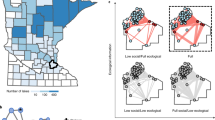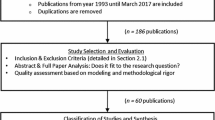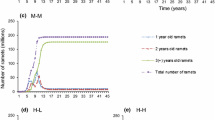Abstract
Recent analyses demonstrate that the spatial–temporal behavior of invasive species requires optimal management decisions over space and time. From a spatial perspective, this bioeconomic optimization model broadens away from invasive species spread at a frontier or to neighbors by examining short and long-distance dispersal, directionality in spread, and network geometry. In terms of uncertainty and dynamics, this framework incorporates several sources of stochasticity, decisions with multi-year implications, and temporal ecological processes. This paper employs a unique Markov decision process planning algorithm and a Monte Carlo simulation of the stochastic system to explore the spatial-dynamic optimal policy for a river network facing a bioinvasion, with Tamarisk as an example. In addition to exploring the spatial, stochastic, and dynamic aspects of management of invasions, the results demonstrate how the interaction of spatial and multi-period processes contributes to finding the optimal policy. Those interactions prove critical in determining the right management tool, in the right location, at the right time, which informs the management implications drawn from simpler frameworks. In particular, as compared to other modeling framework’s policy prescriptions, the framework here finds more use of the management tool restoration and more management in highly connected locations, which leads to a less invaded system over time.









Similar content being viewed by others
Notes
Because the structure of Equation 7 in the dispersal matrix is undefined when \(u=d\), we set \(d=0.15\) and \(u=0.1\).
This dispersal matrix change reduces the size of the transition matrix because the short-distance spread assumption reduces the number of possible landscapes that can occur after spread. For example, the assumption reduces the need to consider the impact of treating an upstream reach on the most downstream reach because an upstream invasion cannot disperse directly to that reach in one time period
References
Albers HJ (1996) Modeling ecological constraints on tropical forest management: spatial interdependence, irreversibility, and uncertainty. J Environ Econ Manag 30(1):73–94
Albers HJ, Goldbach MJ (2000) Irreversible ecosystem change, species competition, and shifting cultivation. Resour Energy Econ 22:261–280
Burnett K, Kaiser B, Pitafi BA, Roumasset J (2006) Prevention, eradication, and containment of invasive species: illustrations from Hawaii. Agric Resour Econ Rev 35(1):63
Clopper CJ, Pearson ES (1934) The use of confidence or fiducial limits illustrated in the case of the binomial. Biometrika 26(4):404–413
Chadès I, Martin TG, Nicol S, Burgman MA, Possingham HP, Buckley YM (2011) General rules for managing and surveying networks of pests, diseases, and endangered species. Proc Natl Acad Sci 108(20):8323–8328
Eiswerth ME, Van Kooten GC (2002) Uncertainty, economics, and the spread of an invasive plant species. Am J Agric Econ 84(5):1317–1322
Epanchin-Niell RS, Hastings A (2010) Controlling established invaders: integrating economics and spread dynamics to determine optimal management. Ecol Lett 13(4):528–541
Epanchin-Niell RS, Wilen JE (2012) Optimal spatial control of biological invasions. J Environ Econ Manag 63(2):260–270
Epanchin-Niell RS, Wilen JE (2015) Individual and cooperative management of invasive species in human-mediated landscapes. Am J Agric Econ 97(1):180–198
Everitt BL (1998) Chronology of the spread of tamarisk in the central Rio Grande. Wetlands 18(4):658–668
Fenichel EP, Richards TJ, Shanafelt DW (2014) The control of invasive species on private property with neighbor-to-neighbor spillovers. Environ Resour Econ 59(2):231–255
Hall K (2014) Optimal spatial-dynamic resource allocation facing uncertainty: integrating economics and ecology for invasive species policy. Dissertation, Oregon State University
Hampe A, Petit RJ (2005) Conserving biodiversity under climate change: the rear edge matters. Ecol Lett 8(5):461–467
Hanski I (1998) Metapopulation dynamics. Nature 396(6706):41–49
Homans F, Horie T (2011) Optimal detection strategies for an established invasive pest. Ecol Econ 70(6):1129–1138
Hulme PE (2006) Beyond control: wider implications for the management of biological invasions. J Appl Ecol 43(5):835–847
Keith DA, Akçakaya HR, Thuiller W, Midgley GF, Pearson RG, Phillips SJ, Regan HM, Araújo MB, Rebelo TG (2008) Predicting extinction risks under climate change: coupling stochastic population models with dynamic bioclimatic habitat models. Biol Lett 4(5):560–563
Konoshima M, Montgomery CA, Albers HJ, Arthur JL (2008) Spatial-endogenous fire risk and efficient fuel management and timber harvest. Land Econ 84(3):449–468
Kovacs KF, Haight RG, Mercader RJ, McCullough DG (2014) A bioeconomic analysis of an emerald ash borer invasion of an urban forest with multiple jurisdictions. Resour Energy Econ 36(1):270–289
Muneepeerakul R, Weitz JS, Levin SA, Rinaldo A, Rodriguez-Iturbe I (2007) A neutral metapopulation model of biodiversity in river networks. J Theor Biol 245(2):351–363
Olson LJ, Roy S (2002) The economics of controlling a stochastic biological invasion. Am J Agric Econ 84(5):1311–1316
Sanchirico JN, Albers HJ, Fischer C, Coleman C (2010) Spatial management of invasive species: pathways and policy options. Environ Resour Econ 45(4):517–535
Schopmeyer CS tech coord (1974) Seeds of woody plants in the United States. Washington DC
Sher AA, Marshall DL (2003) Seedling competition between native Populus deltoides (Salicaceae) and exotic Tamarix ramosissima (Tamaricaceae) across water regimes and substrate types. Am J Bot 90(3):413–422
Sims C, Finnoff D (2012) The role of spatial scale in the timing of uncertain environmental policy. J Econ Dyn Control 36(3):369–382
Sims C, Aadland D, Powell J, Finnoff DC, Crabb B (2014) Complementarity in the provision of ecosystem services reduces the cost of mitigating amplified natural disturbance events. PNAS 111(47):16718–16723
Smith MD, Sanchirico JN, Wilen JE (2009) The economics of spatial-dynamic processes: applications to renewable resources. J Environ Econ Manag 57(1):104–121
Stevens LE (2002) Exotic tamarisk on the Colorado Plateau In: Grahame JD, Sisk TD (eds) Canyons, cultures and environmental change: an introduction to the land-use history of the Colorado Plateau. U.S.Geological Survey
Stromberg J (1998) Dynamics of Fremont cottonwood (Populus fremontii) and saltcedar (Tamarix chinensis) populations along the San Pedro River, Arizona. J Arid Environ 40(2):133–155. doi:10.1006/jare.1998.0438
Sutton RS, Barto AG (1998) Reinforcement learning: an introduction. MIT Press, Cambridge
Taleghan MA, Dietterich TG, Crowley M, Hall K, Albers HJ (2015) PAC optimal MDP planning with application to invasive species management. J Mach Learn Res 16:3877–3903
Tamarisk Coalition (2009) Appendix H: Riparian restoration. Assessment of Alternative Technologies for Tamarisk Control, Biomass Reduction, and Revegetation. In: Colorado River Basin Tamarisk and Russian Olive Assessment
Thomas CD, Cameron A, Green RE, Bakkenes M, Beaumont LJ, Collingham YC, Hughes L (2004) Extinction risk from climate change. Nature 427(6970):145–148
Wu J, Skelton-Groth K (2002) Targeting conservation efforts in the presence of threshold effects and ecosystem linkages. Ecol Econ 42(1):313–331
Wadsworth RA, Collingham YC, Willis SG, Huntley B, Hulme PE (2000) Simulating the spread and management of alien riparian weeds: are they out of control? J Appl Ecol 37(s1):28–38
Zavaleta E (2000) The economic value of controlling an invasive shrub. AMBIO J Hum Environ 29(8):462–467
Acknowledgements
Funding was provided by National Science Foundation (0832804, 1331932).
Author information
Authors and Affiliations
Corresponding author
Appendix
Appendix
The code for the simulator can be obtained from
http://2013.rl-competition.org/domains/invasive-species
We assume we are given:
-
1.
The state space S.
-
2.
The action space A.
-
3.
A simulator \(:S\times A\rightarrow S\times {\mathbb {R}}\). Given a state s and an action a, the simulator produces the next state \(s'\) and the immediate (deterministic) reward r according to a probability distribution \({\upvarphi } (s'| s,a)\).
-
4.
A discount factor \(\gamma \)
-
5.
A confidence level \({\updelta }\)
-
6.
An error tolerance \(\upepsilon \)
Data Structures:
-
1.
\(N(s,a,s'):\) Number of times that the transition \((s,a)\rightarrow s'\) has been observed.
-
2.
\(N(s,a)=\sum \nolimits _{s'} {N(s,a,s')}\). The number of times that action a has been simulated in state s.
-
3.
\(\hat{{\varvec{\varphi }}}(\mathrm {s}'|\hbox {s},\hbox {a})\): The maximum likelihood estimate of the transition probabilities:
$$\begin{aligned} N(s,a,s')/N(s,a). \end{aligned}$$ -
4.
A(s): The set of actions that can be executed in state \(\mathrm {s}\).
-
5.
R(s, a): The reward of taking action a in state s
-
6.
V(s): The value function for state s
-
7.
Q(s, a): The state-action value function for (s, a)
-
8.
\(\pi (s)\): The (deterministic) policy, which is a mapping from states to actions, \(\pi {:}\,S\rightarrow A\)
Algorithm 1: \(\pi =\hbox {Planner}(S,A,\delta ,\epsilon )\)
-
1.
Initialization
-
a.
\(Q(s,a)=0\) for all (s, a)
-
b.
\(V(s)=0\) for all s
-
a.
-
2.
\((R,\hat{\varphi })=\) Call Sampler(\(S,A,\delta ,\epsilon \))
-
3.
Repeat %value iteration
-
a.
\(\mathrm {\Delta }=0\)
-
b.
For each \(s\in S\)
-
i.
\(v=V(s)\)
-
ii.
For each \(a\in A(s)\)
$$\begin{aligned} 1. \quad Q(s,a)=R(s,a)+\gamma \sum \nolimits _{s'\in S} {\hat{\varvec{\varphi }}}(s'|s,a) \max \nolimits _{a'} Q(s',a') \end{aligned}$$ -
iii.
\(V(s)=\max \nolimits _{a} Q(s,a)\)
-
iv.
\({\Delta }=\max ({\Delta },|v-V(s))\)
Until \({\Delta }<\epsilon ({\textit{small}}\; {\textit{positive}}\;{\textit{number}})\)
-
i.
-
a.
-
4.
\(\pi (s)={\textit{argmax}}_{a}Q(s,a)\) for each \(s\in S\)
-
5.
Return \(\pi \)
Algorithm 2: \((R,{\hat{\varvec{\varphi }}})=\hbox {Sampler}(S,A,\delta ,\epsilon )\)
-
1.
Initialization
-
a.
\(R(s,a)=0\) for all (s, a)
-
b.
\(N(s,a,s')=0\) for all \((s,a,s')\)
-
a.
-
2.
For each \(s\in S\)
-
a.
For each \(a\in A(s)\)
-
i.
Repeat
-
1.
Invoke the simulator F on (s, a) and obtain \((R(s,a),s')\)
-
2.
Update \(N(s,a,s'), N(s,a)\), and R(s, a)
-
3.
\(\Delta (\mathrm {s}')\)=Clopper-Pearson confidence bound using \(N(s,a,s'), N(s,a), \delta \)
Until \(\max _{{\mathrm{s}}\prime }\Delta (\mathrm {s}')<\epsilon \)
-
1.
-
ii.
\(\hat{{\varvec{\varphi }}}(s'|s,a)=N(s,a,s')/N(s,a)\) for each \(s'\in S\)
-
i.
-
a.
-
3.
Return \(R,\varphi \)
Rights and permissions
About this article
Cite this article
Hall, K.M., Albers, H.J., Alkaee Taleghan, M. et al. Optimal Spatial-Dynamic Management of Stochastic Species Invasions. Environ Resource Econ 70, 403–427 (2018). https://doi.org/10.1007/s10640-017-0127-6
Accepted:
Published:
Issue Date:
DOI: https://doi.org/10.1007/s10640-017-0127-6




